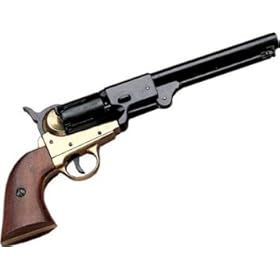Click the Image To Look Inside:
A non-firing copy of the Colt 1860 classic, used extensively in the Civil War. This piece replicates the original in size, weight and appearance, and the parts function much like the original. However, parts cannot be interchanged or the replica made to fire ammunition.
Once I got this pistol on Amazon, I started looking into what it really was. The label said "1860 Replica Revolver" and I assumed it was a Colt but the Colt 1861 looked quite different in front of the cylinder. I thought it was a Colt 1851 Navy but I noticed some differences there, too. I hadn't seen any 1851s with the brass frame and the true 1851 had an engraving of a naval battle on the cylinder. Having purchased a LeMat replica from the same manufacturer (Denix S.A.) and that they identify it on the website as a Colt 1886, I assumed that many liberties had been taken with the construction.
In fact, I learned that this is not a Colt revolver at all but a Confederate copy of the Colt revolver. In 1862, the Confederate Ordnance Department selected Griswold and Gunnison to make all the pistols they possibly could. Samuel Griswold operated a cotton gin factory in Georgia before the war so he and Arvin N. Gunnison set up their manufacturing operation there. Their pistols were almost exact replicas of the Colt 1851 Navy pistol. The main differences between the two pistols were the brass frame instead of steel and a round barrel. The Confederate army used brass because of a shortage of suitable metals. The pistols were of good quality but the company was only able to make 3,600 pistols during its three year existence. The revolvers were sold to the Southern army for an astounding price of $40 each. The factory was destroyed by General Sherman in 1864.
This is a reasonable replica. At first glance, someone who knew his pistols would identify it for the Griswold & Gunnison Model 1862 or at least recognize it as a variation of the Colt 1851 Navy. On closer inspection, screws are out of place. There's a casting sprue mark on the face of the cylinder. The frame is split into two pieces. Minor things, I think. The loading lever operates. The original was .36 caliber. I measured the barrel at .32 caliber and the cylinder chambers at .38 caliber. It probably wouldn't be too difficult to re-bore the barrel since it's not made out of a hard metal like steel. It feels a bit light. I couldn't find any specs on the Confederate pistol but the Colt 1851 weighs 2lbs 10oz. I weighed this pistol at 2lb 3 7/8 oz. Some lead balls in the cylinder to simulate the pistol being loaded would also add some weight to heft it out a little. For a few chambers, the cylinder over-rotates slightly so that the hammer doesn't fall squarely in place. I haven't taken it apart yet to see if there is anything to be done to correct that minor flaw. The action sounds a bit clunky, unlike the crisp clicks of an actual firearm
I like the two-tone style that the brass frame gives the pistol. The dealer (Netlink Enterprises) delivered it quickly. All told, not bad for $75.


No comments:
Post a Comment